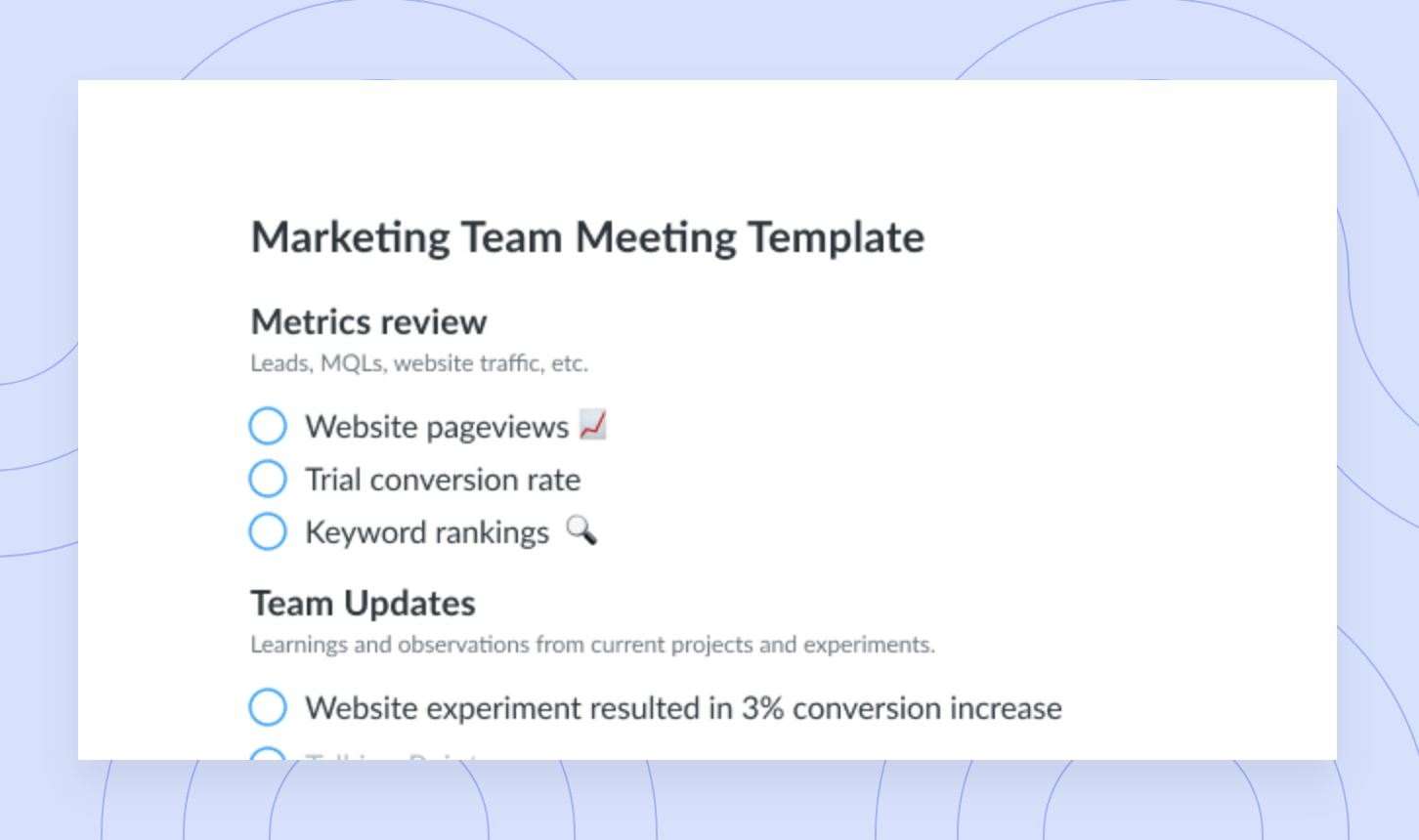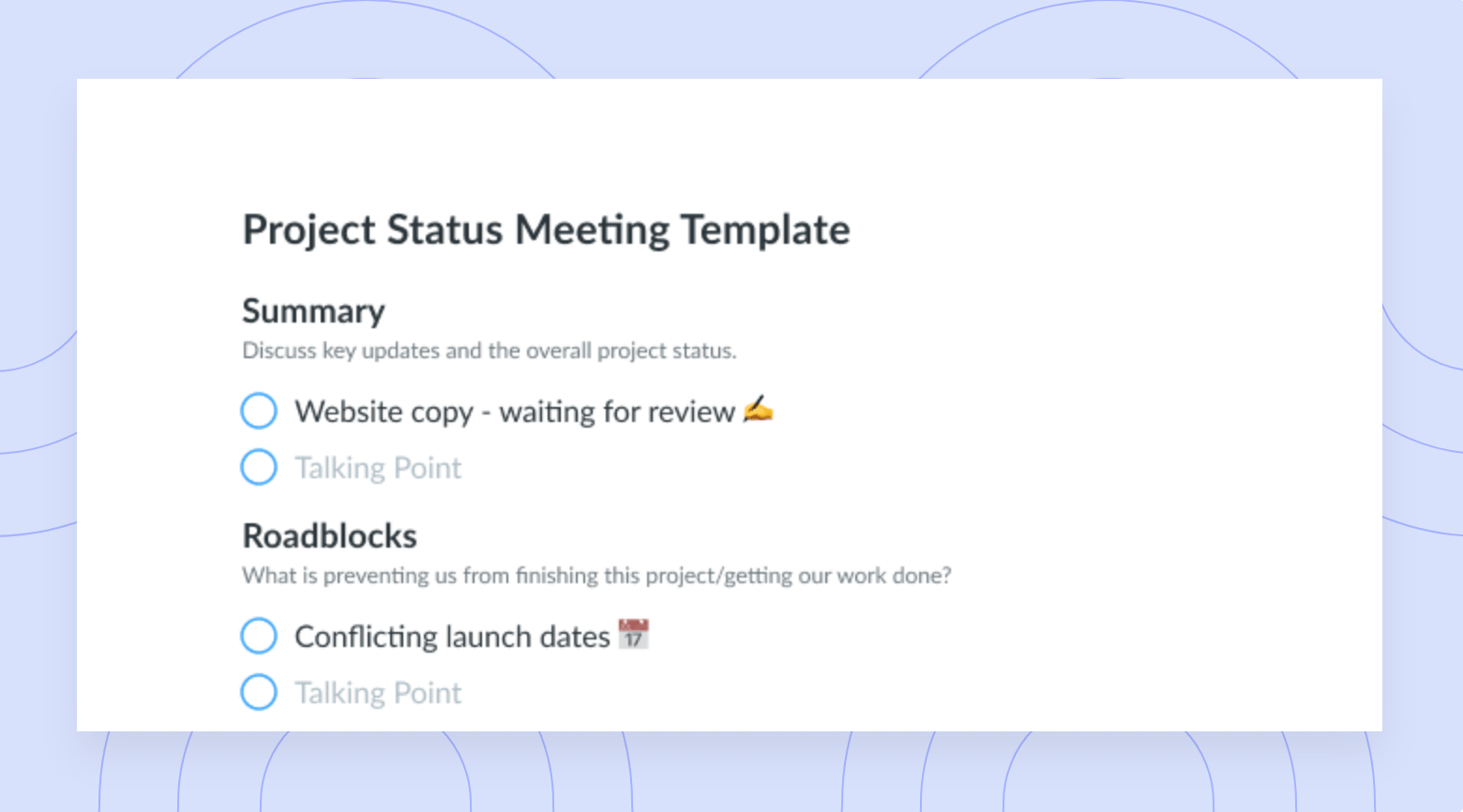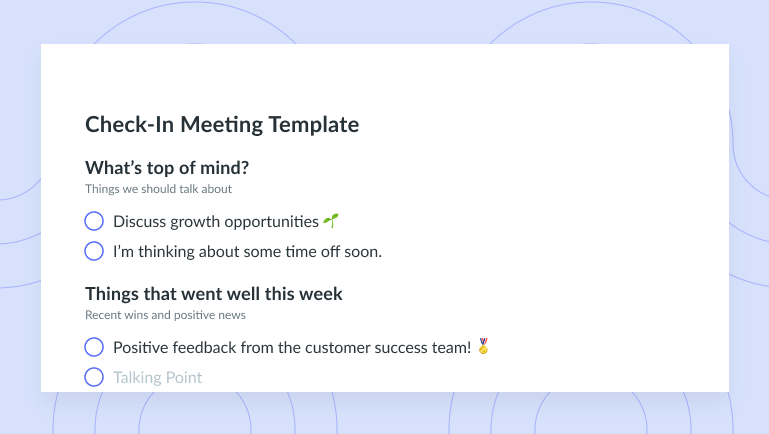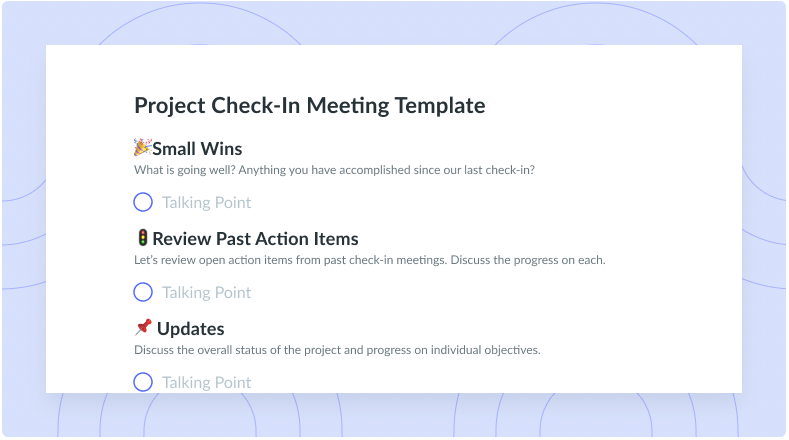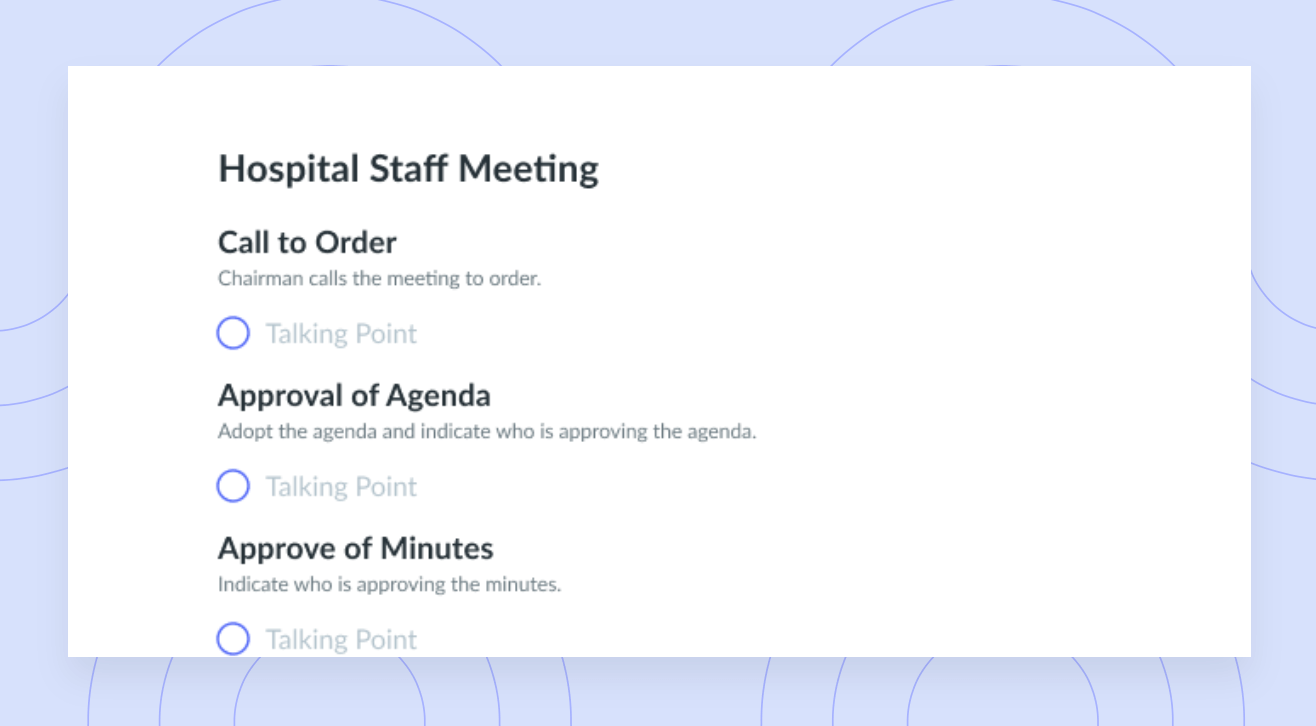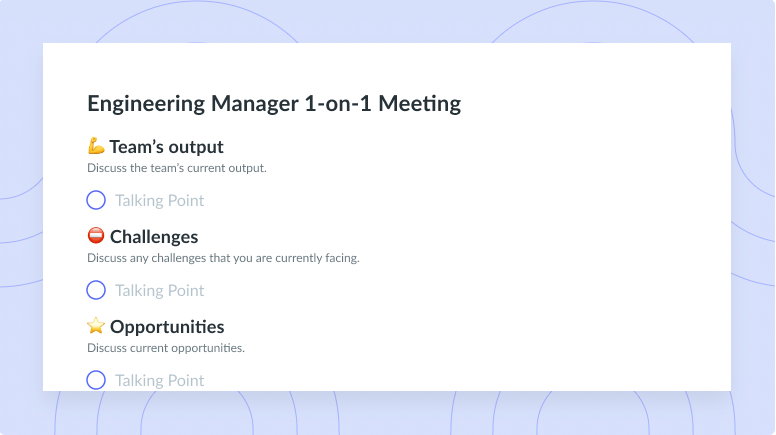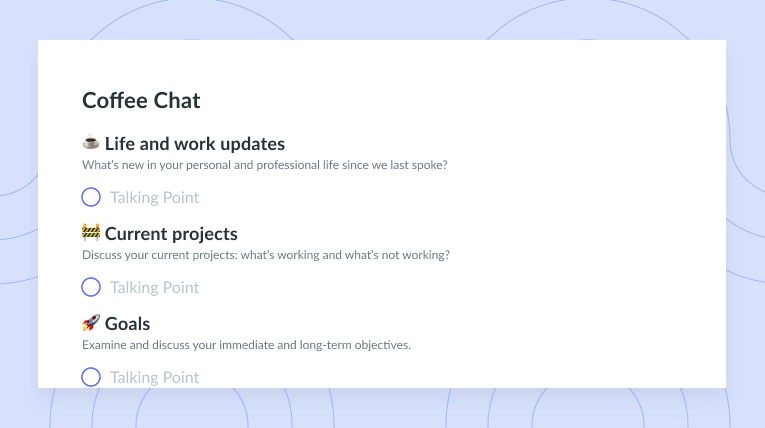Discovery Meeting: Free Template (+ 25 Questions) for Effective Sessions
Find out about the purpose of conducting discovery meetings, the types of questions you should ask your potential clients to find success.
Whether you’re in Sales or project management, you’re probably more than familiar with a discovery meeting. A discovery meeting is essential to building long and lasting relationships with new customers or clients. In order to improve your customers’ business processes, you need to truly understand their needs as an organization. The discovery meeting is largely influenced by something called a kaizen process or a kaizen event. Kaizen is a Japanese business philosophy based on the concept of continuous improvement and personal efficiency.
Keeping this philosophy in mind, Fellow is going to take you through what a discovery meeting is, what it’s purpose is, what kinds of questions to ask, some meeting agenda templates and finally, some useful tips.
- What is a discovery meeting?
- What is the purpose of a discovery call?
- Questions to ask in a discovery call
- Discovery meeting templates
- 8 Tips for an optimal discovery meeting
What is a discovery meeting?
A discovery meeting is a discussion between one or more team members from your business or sales team and a lead or potential customer. As the individual or team offering a product or a service, this meeting helps you understand what gaps exist for your potential customers and how you can fill those gaps. For this reason, it’s really important that your discovery meeting is centered on learning about one another, about each of your business processes, each other’s organizational goals, and what kind of true value you can bring to your potential customer. You’ll also need to identify who the decision-makers are so that you can understand who you need to speak with to seal the deal. While these meetings are most ideally conducted face to face, a virtual meeting can be just as effective.
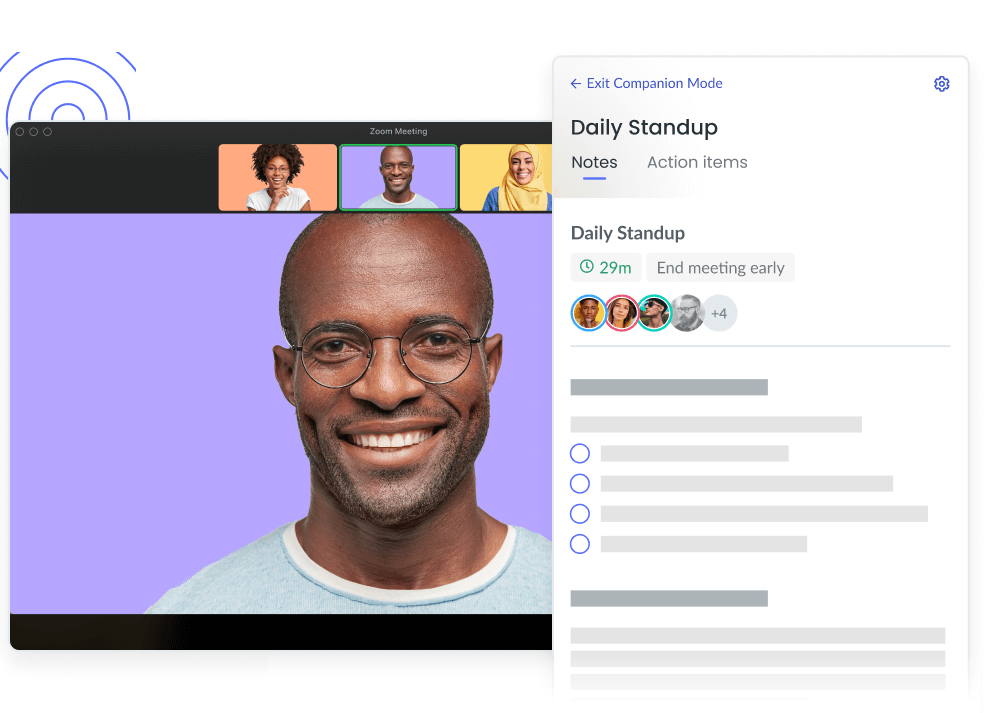
What is the purpose of a discovery call?
The true purpose of a discovery call is to recognize if this customer is a good fit for what you and your organization are actually offering. You want to make sure that you can qualify this lead and that this relationship is going to add value for both parties. This meeting is specifically for learning about your potential customers’ organization, listening to gaps they may have, and thinking about if you have the ability to fill them. This is a relationship that should not be forced. If there is some kind of misalignment, you haven’t quite found your target market. Once your discovery calls are a win-win situation on a consistent basis, you’ll know that you’re prospecting the right individuals and companies. This is a vital meeting because once your discovery meeting goes well, you can move on to the proposal stage, a deal, and ultimately, a sale.
Questions to ask in a discovery call
Steer clear from reading questions from a rehearsed list for your discovery calls. Instead, consider asking some of these questions below to yield detailed and straightforward responses.
- What’s your biggest challenge as it relates to X?
- How many opportunities have you missed as a result of this problem?
- How much money would you save each month by resolving Y?
- Has it impacted your organization’s morale? How so?
Discovery meeting templates
Because every meeting is made better with a meeting agenda, try using one of these discovery meeting templates to encourage organization and to drive productivity:
Sales Discovery Call Template
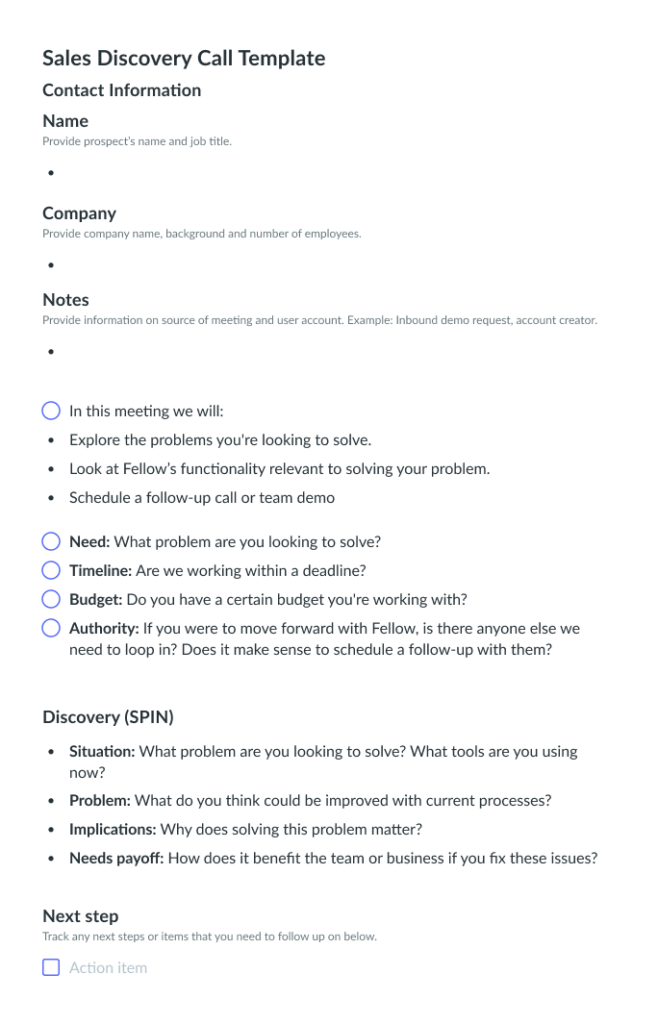
Sales Discovery Meeting Template curated by Gong

Sales Call Agenda Template

8 Tips for an optimal discovery meeting
- Do your research
- Send an agenda in advance
- Start on a positive note
- Focus on pain points and challenges
- Phrase your questions to get long answers
- Showcase your expertise
- Ask about their budget
- Set clear next steps
1 Do your research
Don’t bother setting up a meeting unless you’ve genuinely taken the time to read and research the individual you’re calling as well as the company they work with. Your prospect cares about their needs and their valuable time. Unless you impress your potential client from the get-go, they won’t be taking time from their busy schedule to humor you. In a recent article by Inc, they build on this, sharing:
“Don’t talk about your company’s history, your experience, or the features of your product or service. Instead, focus your entire conversation on the prospect, and they’ll be much more interested in engaging with you.”
2 Send an agenda in advance
Any meeting is made more productive and more effective when you use a meeting agenda. Not only does your meeting agenda prepare everything that you need in order to conduct the meeting as well as come up for topics of discussion, but it also shows respect to your potential lead. Because you respect their valuable time, your meeting agenda demonstrates that you want to maximize efficiency and engage in a valuable conversation. Sending your meeting agenda in advance shows professionalism, preparedness and will lead to mutual respect between you and your leads.

Run delightful discovery meetings
Increase meeting engagement and productivity with a collaborative agenda that the whole team can contribute to. Try using a tool like Fellow!

3 Start on a positive note
As much as you need to cut to the chase pretty in a discovery meeting, it’s still important to start the call on a positive note. As you know, in Sales, you need to be able to read the room and understand if you’re being well received. If you feel like the opportunity is right, ask your lead about their day, about how their weekend was, or literally anything that will make you come off as genuine and personable. A great way to start your conversation on a positive note is to let your lead know that you’ve done your research and you genuinely think that you have a product or service that can help them- there’s nothing more positive than that!
4 Focus on pain points and challenges
In order to focus on pain points and challenges, a recent blog post by Close suggests the following:
“Use insights gathered from conversations with other prospects and your own research on this prospect to discuss the state of their industry and the problems they’re currently facing. Guide this conversation with the right questions that lead them to your solution.”
Whatever products or services that you offer should address the customers ‘pain points’ head-on. Your job is to use your product or service to meet your customer’s needs, which is why it’s important that you ask your lead to describe the challenges that they’ve been facing and how they would like you to help. This is where you need to make an honest evaluation of if what you offer genuinely aligns with what the customer is looking for. Again, this is something that should not be forced. If their needs don’t align with what you offer, be honest about it and hit your lead sheet to make the next call.
5 Phrase your questions to get long answers
Don’t just ask questions to check them off of a list. The goal of your inquiries is to yield as much information as possible and as much clarification on what kinds of issues your potential customers’ business is facing. Using open-ended questions and clarifying questions will ask your customers to dig deeper and provide you with more detailed responses. It’s a good idea to ask questions about their challenges, budget, mission, goals, and values to be sure that they align with yours and to ensure that there is a strong synergy between you.
6 Showcase your expertise
Start with showcasing your expertise and then use it as leverage, in terms of what you know about the industry, the products or services, common challenges, and concerns. Describe how your products or services address these concerns and why you can truly add value to their business processes to foster continual improvement. Your level of knowledge and expertise often determines if this lead will turn into a long-term client. In an article by Inc, they build on this idea stating:
“Whether you realize it yet or not, you’re an expert in your industry with a unique bird’s-eye-view of trends among your customers. This perspective is extremely valuable to your prospects, so make it a priority to come off as the expert with your prospects in sales meetings. Start by sharing things you’ve seen work–or not work–for your customers. This will make you an expert in your prospects’ eyes, and they’ll want to keep the conversation going to learn more from you.”
7 Ask about their budget
Some people shy away from asking a potential customer about their budget, which is a huge mistake. It’s important to understand what kind of budget your lead is working with so that you can determine if you’re the right fit to help this company. When asking your lead about their budget, make sure that you’re also being open and honest with them about the pricing of your products and services. This way, you can align their budget with what you offer, or otherwise let them know that you might be too pricey for the funds they have available. In the same article by Inc, they provide a unique way of discussing budget with potential customers:
“A lot of old-school sales trainers claim, “Prospects will never give you a budget, so don’t bother asking.” They’re wrong. Once you’ve established the cost of key challenges, it makes sense to ask, “Now, what are you willing to invest in solving the problem?” This simple approach works and sets you up to ultimately close more sales.”
8 Set clear next steps
If your prospect is certain about their decision to partner with you, you must set clear next steps and go through both their expectations and your own. Action occurs after the discovery meeting, which means that it’s very important for you to send meeting minutes from your discovery meeting, which clearly outline next steps in the process. It’s a good idea to also set up a follow-up meeting so that you can touch base and continue working productively towards your mutual goals. Exchange full contact information, organize your stream mapping for the project (with the intent of eliminating waste), organize a demo, and select a method of payment for your products or services. Establish concrete dates for these next steps and be sure to ask if anyone else should be included in subsequent meetings.
Parting advice
Discovery meetings are essential in sales and business planning. When you know that your organization offers a product or service that is going to drive process improvements, it’s only a matter of finding the appropriate target market. The next time you take a look at your lead sheet, consider revisiting this article in order to go over the purpose of a discovery meeting, questions that you should ask, and tips that will boost your effectiveness. Try out a discovery meeting template in order to remain as organized and as prepared as possible. Don’t forget to create your meeting agenda in advance to show your potential customer that you respect and value their time.
As always, it’s a pleasure to see you on the Fellow blog. Until next time, adios!





![How to Have an Effective Reverse Interview [+Examples]](https://fellow.app/wp-content/uploads/2022/07/reverse-interview.jpg)
![12 Tips to Hold Productive Partner Meetings [+ Free Template]](https://fellow.app/wp-content/uploads/2022/05/Productive-Partner-Meetings-2.jpg)


